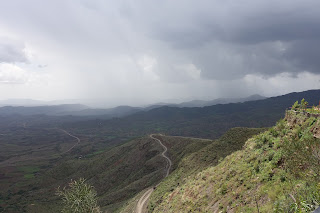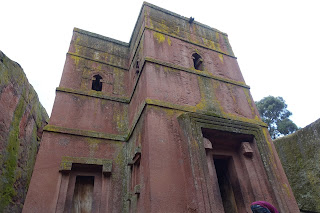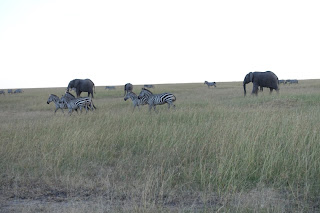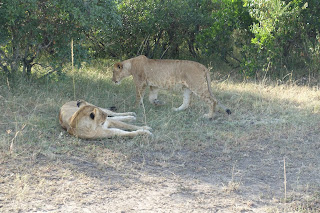Ethiopia
For some reason when I think
of Ethiopia I have a tendency to think of the famine and Live Aid but that was
30 years ago.
I came to Ethiopia for three
main reasons.
1) For no particular reason
2) To meet Lucy
3) To see the churches of Lalibela
Unique among African
countries, the ancient Ethiopian monarchy maintained its freedom from colonial
rule with the exception of a short-lived Italian occupation from 1936-41. In
1974, a military junta, the Derg, deposed Emperor Haile SELASSIE (who had ruled
since 1930) and established a socialist state. Torn by bloody coups, uprisings,
wide-scale drought, and massive refugee problems, the regime was finally
toppled in 1991 by a coalition of rebel forces, the Ethiopian People's
Revolutionary Democratic Front. A constitution was adopted in 1994, and
Ethiopia's first multiparty elections were held in 1995. A border war with
Eritrea in the late 1990s ended with a peace treaty in December 2000. In
November 2007, the Eritrea-Ethiopia Border Commission (EEBC) issued specific
coordinates as virtually demarcating the border and pronounced its work
finished. Alleging that the EEBC acted beyond its mandate in issuing the
coordinates, Ethiopia has not accepted them and has not withdrawn troops from
previously contested areas pronounced by the EEBC as belonging to Eritrea. In
August 2012, longtime leader Prime Minister MELES Zenawi died in office and was
replaced by his Deputy Prime Minister HAILEMARIAM Desalegn, marking the first
peaceful transition of power in decades.
No surprises for me in the
capital of Addis. Kind of an unvarnished charm, chaotic, crowded, outdoor markets,
harmless hustlers, safe and nice (and often beautiful people).
Not cheap but not overly
expensive.
Time to meet Lucy. I met Lucy
on line several years ago and had a crush on her ever since. I was not sure if
we would ever meet but we kept up whenever
we could and finally we would go on a date. I knew her to be sexy, tough, independent and a few years
older than me but I was enchanted nonetheless. So I get all gussied up and with
nervous anticipation I make my way to see her. When I said she was a few years
older let me tell you more about this little gal:
Lucy, or Dinknesh (meaning 'you are amazing' in Amharic), is diminutive – she measures a little over 1m – formed the
centrepiece of an exhibition charting more than 6 million years of human evolution
that showed that Ethiopia was the cradle of mankind.
She is about 3.2 million years
old and walked upright but still comfortable in the trees. She is one of kind.
Literally, she is a halfway house between the great apes and the humans we know
today. Lucy tells us that several
distinct hominins — species more closely related to humans than to chimps roamed eastern Africa more than 3 million
years ago.
She is not shy, a lot of her is on display on the Natural
Museum in Addis and is very photogenic. Well I could gush for hours but you
will see her beauty in some of my photos.
Now that I was so smitten with
the lovely Lucy it was time to go to the chapel.
The Churches of Lalibela.
A quick flight to the
highlands and I was in Lalibella.
The small town
of Lalibela in Ethiopia is
home to one of the world's most astounding sacred sites: eleven rock-hewn
churches, each carved entirely out of a single block of granite with its roof
at ground level.
Were it not for these
extraordinary churches, Lalibela would almost certainly be well off the tourist
radar. A dusty rural town nestled into rolling countryside, Lalibela only
recently received electricity. It has few motorized vehicles, no gas stations
and no paved streets. Isolated from the modern world, the town goes about its
business much as it has for several hundred years.
Of Lalibela's 8-10,000 people,
over 1,000 are priests. Religious ritual is central to the life of the town,
with regular processions, extensive fasts, crowds of singing and dancing
priests. This, combined with its extraordinary religious architecture and
simplicity of life, gives the city of Lalibela a distinctively timeless,
almost biblical atmospher
The town of Lalibela was
originally known as Roha. It was renamed after the 12th-century King
Lalibela, who commissioned these extraordinary churches. Lalibela was a member
of the Zagwe dynasty, which had seized the Ethiopian throne around 1000 AD.
When his rivals began to increase in power, Lalibela sought the support of the
powerful Ethiopian Orthodox Church by building the churches in this small town.
King Lalibela's goal was to
create a New Jerusalem for those who could not make a pilgrimage to
the Holy Land (and to create a sacred city to rival powerful Axum, with
its Ark of the
Covenant). According to some reports, he had been to the Holy Land
himself and was inspired by what he saw. But the king made no attempt to copy
the churches of the Holy Land; in fact, Lalibela's sacred architecture could
not be more unique.
The churches of Lalibela were
not constructed — they were excavated. Each church was created by first carving
out a wide trench on all four sides of the rock, then painstakingly chiseling
out the interior. The largest church is 40 feet high, and the labor
required to complete such a task with only hammers and chisels is astounding.
Popular legend has it
that angels came every night to pick up where the workmen had left
off. One of the churches, Bet Maryam, contains a stone pillar on which King
Lalibela wrote the secrets of the buildings' construction. It is covered
with old cloths and only the priests may look on it.
King Lalibela's project for
gaining the church's favor had two unexpected results: the creation of a holy
place of unparalleled beauty and the king's conversion to a religious
life. After laboring for 20 years, he abdicated his throne to become a hermit,
living in a cave and eating only roots and vegetables. To this day, Ethiopian
Christians regard King Lalibela as one of their greatest saints.
The churches have been in
continuous use since they were built in the 12th century. The first Europeans
to see these extraordinary holy sites were Portugese explorers in the 1520s,
one of whom noted in his journal that the sights were so fantastic, he expected
readers of his descriptions would accuse him of lying.
 |
| Barren women are submerged here |
 |
| 800 years old door that is still working |
 |
| Funky Hotel Room |
 |
| Pure Evil |
 |
| For Hermits |
 |
| Traditional Housing |
 |
| In the Cave |
 |
| Locals |
 |
| Mother and Daughter |
 |
| Tasty |
 |
| Remains of Royals |
 |
| Nun |
 |
| Locals |
 |
| Priest |
 |
| Road |
 |
| Church |
 |
| Before the Nazi's perverted this |
 |
| St. Andrews Cross |
 |
| Yin and Yan Cat |
One of the most amazing thing
for me was that the religious ceremonies have changed very little in 800 years
in the original churches (and chapels).





































































